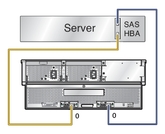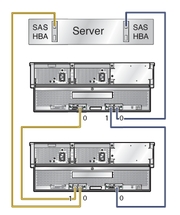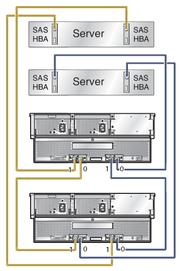| Skip Navigation Links | |
| Exit Print View | |

|
Sun Storage J4500 Array System Overview |
Overview of the Sun Storage J4500 Array
Exterior Features, Controls, and Indicators
Sun Storage J4500 Array Rack Slide Rails
To Place the Array Into Standby Power Mode
AC Power Failure Auto-Recovery
Updated Driver Files Required for Windows
Clustering Software Not Supported With the J4500 Array
Management Options When Using the StorageTek SAS RAID External HBA (Adaptec-Based)
Management Options When Using the StorageTek SAS External HBA (LSI-Based)
Using the Common Array Manager Software
Viewing Sun Storage J4500 Array Information With CAM
Zoning Array Storage Resources Using CAM
Upgrading Sun Storage J4500 Array Firmware Using CAM
Using the StorageTek RAID Manager Software
Viewing Sun Storage J4500 Array Information With the Sun StorageTek RAID Manager
3. Adding and Zoning Array Storage Using CAM
Access Configuration (Zoning) Guidelines
Adding (Cascading) a J4500 Array to An Existing Zoned J4500 Array
To Prepare an Existing Array Prior to Cascading Additional Storage
To Prepare a New J4500 Array for Cascading
Configuring Multiple Host Access for a J4500 Array
To Configure Multiple Host Access for a J4500 Array
Supported Sun Storage J4500 Array Firmware and Common Array Manager (CAM) Software
Supported Operating Systems and Drivers
Supported Drives for Multipath
Multipathing Configuration Guidelines
Multipathing With One Host, One HBA and One Array
Multipathing With One Host, One HBA and Cascaded Arrays
Multipathing With One Host, Two HBAs and Cascaded Arrays
Multipathing With Two Hosts, Four HBAs and Cascaded Arrays
Multipathing With Two Hosts, Multiple HBAs and Cascaded Arrays
Enabling and Disabling Multipathing in the Solaris Operating System
Dynamic Discovery of SAS Devices
To Enable Multipathing on LSI-Based Multipath-Capable Controllers
To Disable Multipathing on LSI-Based Multipath-Capable Controllers
Configuring Multipathing on Selected Ports
Enabling and Disabling Multipathing in the Linux Operating System
To Enable Multipathing in Linux
To Disable Multipathing in Linux
Enabling and Disabling Multipathing in the Windows Operating System
How a Failover is Handled by Windows
To Enable Multipathing in Windows Server 2008
To Disable Multipathing in Windows Server 2008
To Access Service Advisor Procedures
Taking Electrostatic Discharge (ESD) Precautions
To Reserve the Array for Maintenance
To Release the Array After Maintenance
Understanding the CAM Event Log
Troubleshooting Problems with the Array
Check the Event and Performance Logs
Using the Array Management Software to Monitor Enclosure Health
Resetting the Enclosure Hardware
To Reset the Enclosure Hardware Using the Reset Button
Clearing the Enclosure Zoning Password
This section includes examples of supported multipath configurations for your J4500 array.
Note - In the examples below, the colors are used to indicate a specific host path. However, cascade (array-to-array) connections between arrays might, in some cases, be utilized by more than one host in a failover situation.
One Host, One HBA With One Array shows an example of multipath cabling using one host, one HBA and one array. This configuration supports zoned storage and failover.
Figure 4-2 One Host, One HBA With One Array

One Host, One HBA and Two Arrays shows an example of multipath cabling using one host, one HBA and two cascaded arrays. This configuration supports zoned storage and failover.
Figure 4-3 One Host, One HBA and Two Arrays

One Host, Two HBAs and Two Arrays shows an example of multipath cabling using one host, two HBAs and two cascaded arrays. This configuration supports zoned storage and failover.
Figure 4-4 One Host, Two HBAs and Two Arrays

Example Showing Two Hosts, Four HBAs and Cascaded Arrays shows an example of multipath cabling using two hosts, each with two HBAs and two cascaded arrays. This configuration supports clustering, zoned storage and failover. Each server has dual HBAs and dual paths to the cascaded arrays.
Figure 4-5 Example Showing Two Hosts, Four HBAs and Cascaded Arrays

Multiple Hosts, Multiple HBAs with Cascaded Arrays shows an example of multipath cabling using two hosts, each with two multipathed HBAs and four arrays. Both hosts have multipath connections to all four J4500's shown. If you follow any single connection, it goes from one host HBA through two cascaded J4500s and then back to the other host. This allows an HBA in either host to see all 96 drives in one cascaded SAS domain (either SAS A or B). This configuration supports zoned storage and failover. Each server has dual HBAs and dual paths to each cascaded set of arrays.
Figure 4-6 Multiple Hosts, Multiple HBAs with Cascaded Arrays
